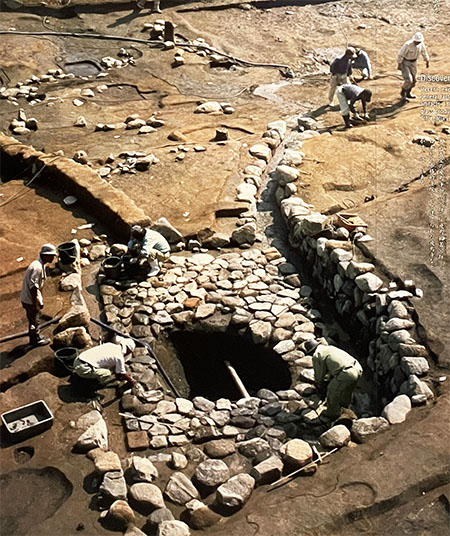

飛鳥の歴史探究シリーズにふたたび取り組んでみたい。
北海道に住んでいて基本的には明治以降に多くの日本人が移住してきて
その最大の足跡とは「日本の住宅革新」ということなのだと思っています。
この事跡についてメディアを立ち上げてその現実に沿って
リアルタイムな住宅建築の状況を人々に伝えるのがわたしの基本的立場。
しかし住宅とはその民族の暮らし方スタイルが正しく反映される。
日本人全体の住環境の来し方行く末を考えるとき、
必然的に日本人的ライフスタイルとの相関関係を見定める必要がある。
そんな動機から歴史的な民族経緯を探究してみたいのです。
幸いにして現代日本では過去に比較して長足の探究の進展がある。
いろいろに鮮明になってくる「生き様」が浮かんできている。
とくに日本のまほろばともいえる飛鳥地域での考古的発見はすばらしい。
人間社会というのは「温故知新」そのものなのでしょうね。
最新の住宅環境性能の進展、そのデザインの進化と同時に
先人たちがどんな状況で、どんな知恵と工夫で生き続けてきたか、
その両方で未来の方向性が確かになってくるものなのでしょう。
飛鳥地域では古事記・日本書紀成立以前、
飛鳥板蓋宮の時代よりもさらに前の時代相も解析されてきている。
大和地方は東・南・西の3方向が山岳に囲まれていて
現代まで水源管理を巡っての相克が社会に色濃く残っていたという。
たくさんの「ため池」が造営され続けてきたとされる。
そうすると農業的土木技術が大いに発展しただろうことが自明。
土木作業というのは大量の人数が動員されて
社会として公共事業として取り組むしか、解決策はない。
大和地域ではそういう土木建築指揮命令機構が発達した。
簡単に言えば、クニの祖型が強い必然性を持って生成された。
そういった権力は同時に社会発展の最先端技術も発展させた。
金属加工についての最先端技術がこの地域全体に広がっている。
それが「池工房遺跡」とされるのですね。
金属加工をすると、必然的にたくさんの水が必要になる。
生産するのには作業工程でつねに大量の水分が不可欠なのだという。
造営された「ため池」はそういう用途との強い関係性が見られる。
池の底の土壌から「富本銭」が出土してくる。
これまでの和同開珎よりもはるか以前から銅銭の加工痕跡。
そしてこうした「池工房遺跡」は飛鳥王権の都城に隣接している。
日本国家の独立を維持し発展させ続けていくためには、
中心権力機構として土木技術発展とともに工業技術発展も推進する必要がある。
経済力の発展こそが国家の最大基盤。
この池工房遺跡の痕跡が残された上に「奈良県立万葉文化館」は建っている。
遺跡の土壌平面から数メートルの上に軽量な建築として建てられた。
飛鳥の時代、考古研究の成果が熱く面白い。・・・
English version⬇
Historical Testimony of the “Ikegakobo Ruins” in Asuka-1
The Asuka area, where the roots of the nation’s national social development lie beneath the gentle countryside. Various roots of Japanese culture continue to be excavated. …
I would like to tackle the Asuka history exploration series again.
Living in Hokkaido, basically since the Meiji era, many Japanese have immigrated to the area.
I believe that the biggest footprint is the “Japanese housing innovation”.
I would like to start a media about this footprint and tell people about the real-time status of housing construction in accordance with this reality.
My basic position is to inform people about the real-time status of housing construction.
However, housing is a true reflection of the way of life of a people.
When considering the future of the Japanese people’s living environment, it is inevitable to consider the correlation between the Japanese lifestyle and the future of the Japanese people.
I must determine the correlation between the Japanese lifestyle and the future of the Japanese living environment.
It is with this motivation that I would like to explore the historical background of the people.
Fortunately, in modern Japan, there has been a long progress of exploration compared to the past.
Various “ways of life” that are becoming clearer and clearer are coming to the surface.
In particular, the archaeological discoveries in the Asuka area, which can be called the Mahoroba of Japan, are wonderful.
Human society is a place of “learning from the past” itself.
The latest progress in housing environmental performance, as well as the evolution of its design
and the wisdom and ingenuity of our predecessors under what circumstances they have continued to live.
Both of these factors will determine the direction of the future.
In the Asuka area, the Asuka Itabatamiya Palace was built before the establishment of the Kojiki and Nihonshoki.
In the Asuka area, the period before the establishment of Kojiki and Nihonshoki, and even before the period of Asuka Itabatamiya Palace, have been analyzed.
The Yamato region is surrounded by mountains on the east, south, and west.
The Yamato region is surrounded by mountains in the east, south, and west directions, and conflicts over the management of water resources remained strong in the society until the present day.
It is said that many “reservoirs” have continued to be built in the Yamato region.
It is obvious that agricultural civil engineering technology would have been greatly developed in this way.
Civil engineering work is a public work that requires the mobilization of a large number of people.
The only solution is to work as a society as a public enterprise.
In the Yamato region, such a command and control structure for civil engineering and construction was developed.
Simply put, the ancestral form of the Kuni was created with a strong sense of inevitability.
Such power also developed the most advanced technology for social development.
Cutting-edge technology regarding metalworking spread throughout the region.
So that is what is considered the “Ikebukuro site.
Metalworking inevitably requires a lot of water.
It is said that a large amount of water is always essential for production in the work process.
The “reservoirs” that were built have a strong relationship with such uses.
Tomimoto coins were excavated from the soil at the bottom of the pond.
These coins were processed much earlier than the Wadokaichin coins.
And these “Ikegakobo ruins” are adjacent to the capital city of the Asuka Kingdom.
In order to maintain and continue to develop the independence of the Japanese nation
The development of industrial technology as well as civil engineering technology must be promoted as the central power structure to maintain and develop the independence of the Japanese nation.
The development of economic power is the most important foundation of a nation.
The Nara Prefecture Complex of Manyo Culture is built on the traces of the Ikegakobo site.
It was built as a lightweight structure a few meters above the soil plane of the ruins.
In the Asuka period, the results of archaeological research are hot and interesting. …
Posted on 6月 20th, 2022 by 三木 奎吾
Filed under: 住宅マーケティング, 歴史探訪







コメントを投稿
「※誹謗中傷や、悪意のある書き込み、営利目的などのコメントを防ぐために、投稿された全てのコメントは一時的に保留されますのでご了承ください。」
You must be logged in to post a comment.